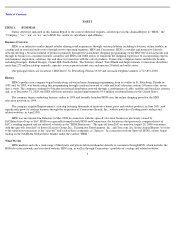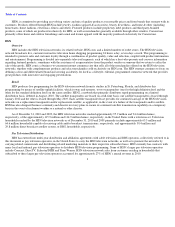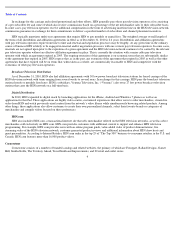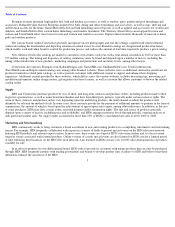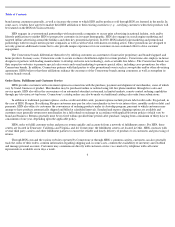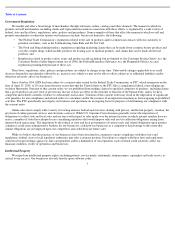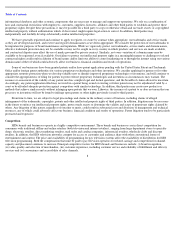Home Shopping Network 2010 Annual Report Download - page 15
Download and view the complete annual report
Please find page 15 of the 2010 Home Shopping Network annual report below. You can navigate through the pages in the report by either clicking on the pages listed below, or by using the keyword search tool below to find specific information within the annual report.
Table of Contents
occasional system interruptions that make some or all systems or data unavailable or prevent our businesses from efficiently providing services
or fulfilling orders. We also rely on affiliate and third-party computer systems, broadband and other communications systems and service
providers in connection with the provision of services generally, as well as to facilitate, process and fulfill transactions. Any interruptions,
outages or delays in our systems and infrastructures, our businesses, our affiliates and/or third parties, or deterioration in the performance of
these systems and infrastructures, could impair our ability to provide services, fulfill orders and/or process transactions. Fire, flood, power loss,
telecommunications failure, hurricanes, tornadoes, earthquakes, acts of war or terrorism, acts of God and similar events or disruptions may
damage or interrupt computer, broadband or other communications systems and infrastructures at any time. Any of these events could cause
system interruption, delays and loss of critical data, and could prevent us from providing services, fulfilling orders and/or processing
transactions. While we have backup systems for certain aspects of our operations, these systems are not fully redundant and disaster recovery
planning is not sufficient for all eventualities. In addition, we may not have adequate insurance coverage to compensate for losses from a major
interruption.
Increased delivery costs could adversely impact our profits, particularly if we are unable to offset them by increasing prices without a
detrimental effect on customer demand.
We are impacted by increases in shipping rates charged by various shipping vendors relating to the procurement of merchandise from
vendors and manufacturers, the shipment of merchandise to customers and the mailing of catalogs, which over the past few years have
experienced volatility in comparison to historical levels. We currently expect that shipping and postal rates will continue to increase. In the case
of deliveries to customers, we have negotiated favorable shipping rates, which increase at agreed upon levels over time, with one independent,
third party shipping company pursuant to a long-term contract. If this relationship were to terminate or if the shipping company was unable to
fulfill its obligations under the contract for any reason, we would have to work with other shipping companies to deliver merchandise to
customers, which could be at less favorable rates and could cause a disruption in our business. Any increase in shipping rates and related fuel
and other surcharges passed on to us by this or any other shipping company may adversely impact profits, given that we may not be able to pass
these increased costs directly to customers or offset them by increasing prices without a detrimental effect on customer demand.
Our long-term success depends, in large part, on our continued ability to attract new and retain existing customers in a cost-effective
manner.
In an effort to attract and retain customers, we engage in various marketing and merchandising initiatives, which involve the expenditure of
considerable money and resources, particularly in the case of the production and distribution of HSN television programming and Cornerstone
catalogs and, to a lesser but increasing extent, online advertising. We have spent, and expect to continue to spend, increasing amounts of money
on, and devote greater resources to, certain of these initiatives, particularly in connection with the growth and maintenance of our brands
generally, as well as in the continuing efforts of our businesses to increasingly engage customers through online channels. These initiatives,
however, may not resonate with existing customers or consumers generally or may not be cost-effective. In addition, we believe that costs
associated with the production and distribution of HSN television programming, paper and printing costs for Cornerstone catalogs and costs
associated with online marketing, including search engine marketing (primarily the purchase of relevant keywords) are likely to increase in the
foreseeable future and, if significant, could have an adverse effect on our business, financial condition and results of operations to the extent that
they do not result in corresponding increases in sales.
We may not be able to accurately predict and/or respond in a timely manner to evolving customer preferences and trends and industry
standards, which could result in excess inventory, related markdowns and lost sales.
Our success depends, in significant part, on our ability to accurately predict, and respond in a timely manner to, changes in customer
preferences and fashion, lifestyle and other trends and industry standards. While product
12


